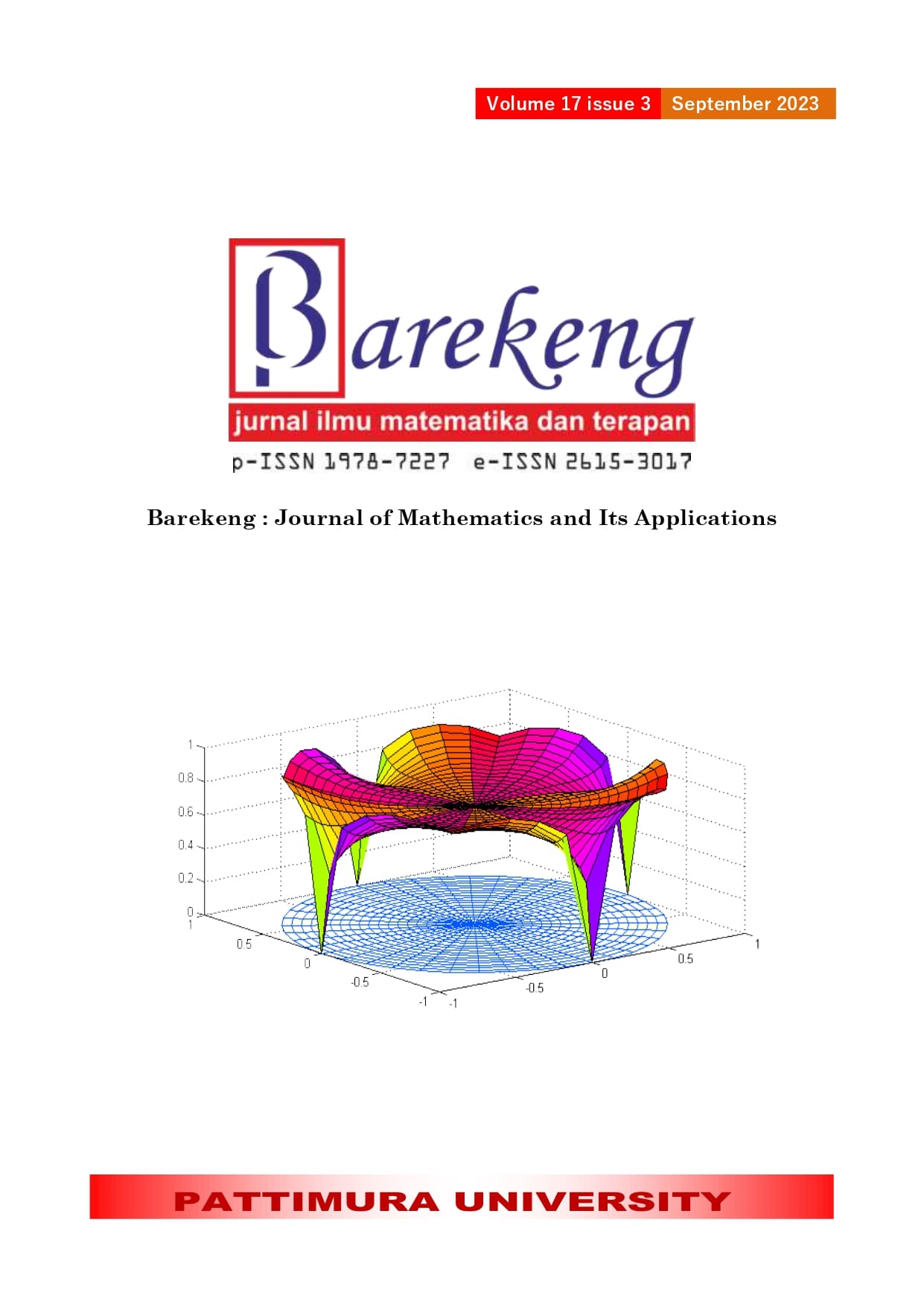MODEL OF TRANSMISSION COVID-19 USING SIQRD MODEL WITH THE EFFECT OF VACCINATION IN MATARAM
Abstract
Mathematical modeling is considered an effective tool for analyzing real-life problems. In this research, we analyze the dynamics of the COVID-19 spread in Mataram city using the SIQRD model with influence of the vaccination. The analyze based on varying some parameter values of the model i.e the transmission rate (β), the recovery rate for COVID-19 (γ), and the death rate (δ), before and after vaccination respectively. Our chosen methodology involves parameter estimation using the Euler method. The result shows that the model has an endemic equilibrium point which remains stable before and after vaccination. Furthermore, the basic reproduction number (R0) which states the number of secondary cases that occur if there are infected people in a population, has the value more than 1 before the vaccination, but equal to 1 after the vaccination. This suggests that prior to COVID-19 vaccination, infected individuals could potentially infect more than one person, but after vaccination, each infected person tends to only infect one other individual. This shift is attributed to the subsidence of COVID-19 symptoms following vaccination
Downloads
References
D. N. Alfian, M. R., Wardhana, I. G. A. W., Maulana, F., Switrayni, N. W., Aini, Q., & Putri, “Prime submodul of an integer over itself,” Eig. Math. J., vol. 27–30, 2022, [Online]. Available: https://doi.org/10.29303/emj.v5i1.132.
A. Kergaßner, C. Burkhardt, D. Lippold, and S. Nistler, “Meso-scale modeling of COVID-19 spatio-temporal outbreak dynamics in Germany,” no. December 2019, pp. 1–21, 2020.
M. Marwan and J. M. Tuwankotta, “Infinitely many Equilibria and Some Codimension One Bifurcations in a Subsystem of a Two-Preys One-Predator Dynamical System,” J. Phys. Conf. Ser., vol. 1245, no. 1, 2019, doi: 10.1088/1742-6596/1245/1/012063.
A. Fuady, N. Nuraini, and K. K. Sukandar, “Targeted Vaccine Allocation Could Increase the COVID-19 Vaccine Benefits Amidst Its Lack of Availability : A Mathematical Modeling Study in Indonesia,” 2021.
R. Kosfeld, K. Wälde, T. Mitze, and J. Rode, “The Covid ‐ 19 containment effects of public health measures : A spatial difference ‐ in ‐ differences approach,” Journal of Regional Science no. March, pp. 799–825, 2021, doi: 10.1111/jors.12536.
N. Nuraini, K. Khairudin, P. Hadisoemarto, H. Susanto, A. Hasan, and N. Sumarti, “Mathematical Models for Assessing Vaccination Scenarios in Several Provinces in Indonesia,” Infectious Disease Modellin no. desember, pp. 1–27, 2020.
P. Steinmann, Steinmann, P. (2020). "Analytical mechanics allows novel vistas on mathematical epidemic dynamics modeling," Mathematics and Mechanics of Complex Systems, 8(4), 321–343. doi:10.2140/memocs.2020.8.
N. Feroze, “Assessing the future progression of COVID-19 in Iran and its neighbors using Bayesian models,” Infect. Dis. Model., vol. 6, pp. 343–350, 2021, doi: 10.1016/j.idm.2021.01.005.
M. Marwan, J. M. Tuwankotta, and E. Harjanto, “Application of Lagrange Multiplier Method for Computing Fold Bifurcation Point in A Two-Prey One Predator Dynamical System,” J. Indones. Math. Soc., no. June 2021, pp. 7–19, 2018, doi: 10.22342/jims.24.2.595.7-19.
A. Molter, R. S. Quadros, M. Rafikov, D. Buske, and G. A. Gonc, “Mathematical Modeling to Perform an Analysis of Social Isolation Periods,” Trends in Computational and Applied Mathematics vol. 4, pp. 595–608, 2021, doi: 10.5540/tcam.2021.022.04.00595.
J. Garman, E. Yang, and S. Macavaney, “SIDIR : E XTENDING SIR WITH D ETECTED AND I SOLATED P OPULATIONS FOR P ANDEMIC M ODELING,” 2020.
M. N. Husni, H. Syafitri, A. M. Siboro, A. G. Syarifudin, Q. Aini, and I. G. A. W. Wardhana, “the Harmonic Index and the Gutman Index of Coprime Graph of Integer Group Modulo With Order of Prime Power,” BAREKENG J. Ilmu Mat. dan Terap., vol. 16, no. 3, pp. 961–966, 2022, doi: 10.30598/barekengvol16iss3pp961-966.
K. Liu and Y. Lou, “Optimizing COVID-19 vaccination programs during vaccine shortages,” Infect. Dis. Model., vol. 7, no. 1, pp. 286–298, 2022, doi: 10.1016/j.idm.2022.02.002.
D. S. Ramdani, I. G. Adhitya, W. Wardhana, and Z. Y. Awanis, “THE INTERSECTION GRAPH REPRESENTATION OF A DIHEDRAL GROUP WITH PRIME ORDER AND ITS NUMERICAL INVARIANTS,” BAREKENG: J. Math. & App., vol. 16, no. 3, pp. 1013–1020, 2022.
A.- Zeneca et al., “C or r e sp ondence Effect of Vaccination on Transmission of SARS-CoV-2,” vol. 70, pp. 2021–2023, 2021, doi: 10.12688/wellcomeopenres.16342.1.
V. Rustagi, M. Bajaj, P. Singh, and R. Aggarwal, “Analyzing the Effect of Vaccination Over COVID Cases and Deaths in Asian Countries Using Machine Learning Models,” Front Cell Infect Microbiol vol. 11, no. February, pp. 1–13, 2022, doi: 10.3389/fcimb.2021.806265.
S. M. Moghadas et al., “The impact of vaccination on COVID-19 outbreaks in the United States,” pp. 1–16, 2021.
DISKOMINFO, “Data COVID-19 NTB,” 2020. https://corona.ntbprov.go.id (accessed Apr. 15, 2020).
M. Nurujjaman, “Enhanced Euler’s Method to Solve First Order Ordinary Differential Equations with Better Accuracy,” J. Eng. Math. Stat., vol. 4, no. 1, pp. 1–13, 2020, doi: 10.5281/zenodo.3731020.
perko, Equations and Dynamical Systems, Third Edit. 1991.
A. Susanto, “KESTABILAN GLOBAL TITIK EQUILIBRIUM MODEL DASAR INFEKSI VIRUS UNTUK HEPATITIS B,” J. Saintek, vol. IV, pp. 42–51, 2012.
A. N. Aziziah, “MODEL SIR PADA EPIDEMI PENYAKIT CAMPAK BERDASARKAN UMUR DENGAN PENGARUH IMUNISASI,” Jurnal Ilmiah Matematika vol. 3, no. 6, 2017.
Copyright (c) 2023 Annisa Zaen Febryantika, Marwan Marwan, Lailia Awalushaumi, Bulqis Nebulla Syechah

This work is licensed under a Creative Commons Attribution-ShareAlike 4.0 International License.
Authors who publish with this Journal agree to the following terms:
- Author retain copyright and grant the journal right of first publication with the work simultaneously licensed under a creative commons attribution license that allow others to share the work within an acknowledgement of the work’s authorship and initial publication of this journal.
- Authors are able to enter into separate, additional contractual arrangement for the non-exclusive distribution of the journal’s published version of the work (e.g. acknowledgement of its initial publication in this journal).
- Authors are permitted and encouraged to post their work online (e.g. in institutional repositories or on their websites) prior to and during the submission process, as it can lead to productive exchanges, as well as earlier and greater citation of published works.






1.gif)



